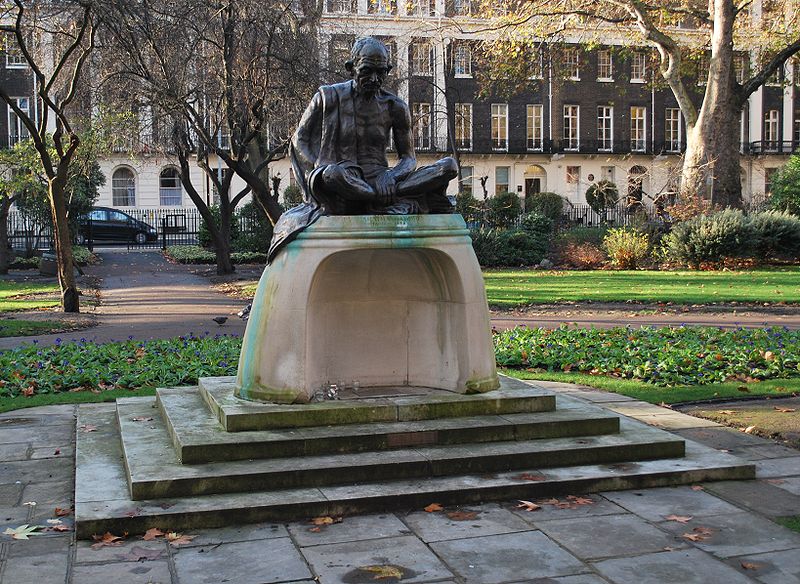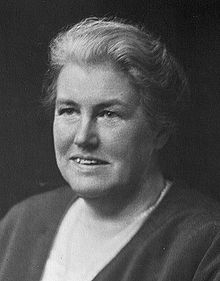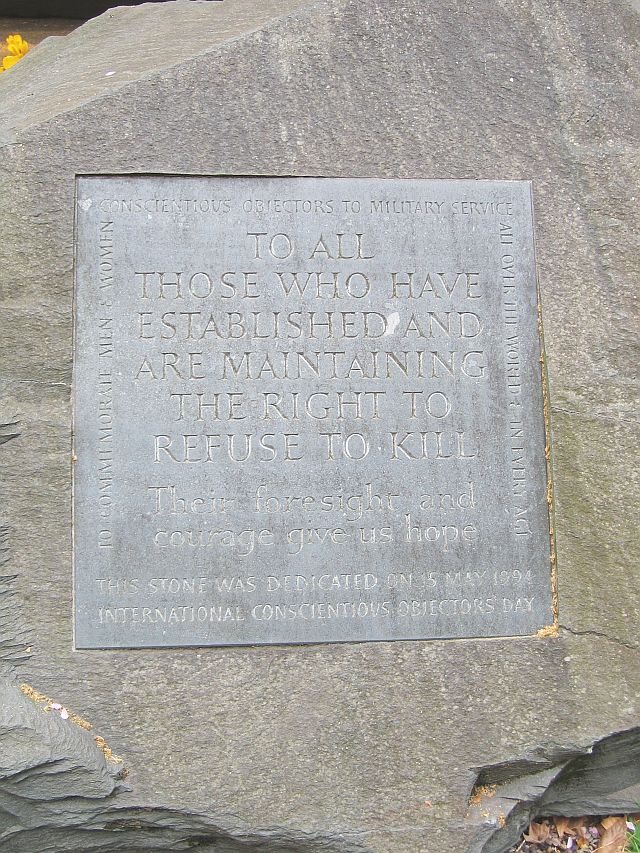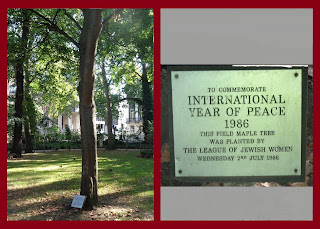It is one of the many squares now surrounded by a fence with a lock and trees offering almost complete privacy. Peeking through the shrubbery, we caught a glimpse of the bust of Virginia Woolf. The other three memorials were a mystery until I started doing some research.
Tavistock Square was built in the 1820s by the property developer James Burton and the master builder Thomas Cubitt for Francis Russell, 5th Duke of Bedford, and formed part of the Bedford Estate in London, owned by the Dukes of Bedford. The square is now owned and administered by the London Borough of Camden. The square takes its name from Francis Russell, Marquess of Tavistock, whose title dates to 1694 when his ancestor was Lord Lieutenant of Tavistock, a market town in Devon, also part of a Bedford estate. Marquess of Tavistock is a courtesy title given to the eldest sons of the Dukes of Bedford.
HIROSHIMA TREE Tavistock Square, London WC1.
Cherry trees from seeds of trees in Hiroshima have been planted in many parts of the country in memory of the thousands killed by the two atomic bombs dropped on Japan.
HIROSHIMA TREE Tavistock Square, London WC1.
Cherry trees from seeds of trees in Hiroshima have been planted in many parts of the country in memory of the thousands killed by the two atomic bombs dropped on Japan. - See more at: http://www.ppu.org.uk/memorials/peace/london/cherrytree.html#sthash.Vfc6xOdZ.dpuf

Statue of Mahatma Ghandi
The centre-piece of the gardens is a statue of Mahatma Gandhi, sculpted by Fredda Brilliant and installed in 1968. The hollow pedestal was intended, and is used, for people to leave floral tributes to the peace campaigner and nonviolent resister to oppression in South Africa and British rule in India.[1]

Virginia Woolf is considered by many to be one of the greatest British writers, for her timeless exploration of the human condition but also for addressing the key anxieties of the post-first world war society.
A born-and-bred Londoner, she was a key member of the highly influential Bloomsbury Group who lived in that quarter while producing some of the most influential and poignant literary texts of the 20th century.
'Then one day walking round Tavistock Square I made up as I sometimes make my book, To the Lighthouse, in a great, apparently involuntary rush."As a woman seeking further education in the late Victorian age, Woolf was only able to attend King’s Ladies’ department, which was not located at the main campus but at 13 Kensington Square, close to her family home. She studied subjects including Latin, Greek and History between 1897 and 1901, while both her brothers Thoby and Adrian attended Trinity College Cambridge. This experience of entrenched gender inequality surely left an impression on Woolf and, perhaps, even influenced her seminal 1929 essay A Room of One’s Own.
A Room of One's Own spoke to me. As a busy mother of six children, I had little time of my own without mentioning a room of my own. I longed for a place that was mine alone where I could shut myself away from the demands of my life. Big ones and small ones. I still have times when I crave that solitude.
A bust of the writer Virginia Woolf, cast from a 1931 sculpture by Stephen Tomlin (1901–1937), was unveiled in 2004 at the southwest corner of the square. Woolf lived at 52 Tavistock Square between 1924 and 1939. From there she and her husband Leonard Woolf ran the Hogarth Press, which became a prominent and influential publisher at the forefront of modernist fiction and poetry (publishing T.S. Eliot, E.M. Forster and Katherine Mansfield among others) and translating the works of Sigmund Freud into English. Their house was destroyed by a bomb in October 1941 during the London Blitz. The south side of the square where Woolf lived is now occupied by a hotel.
Dame Louisa Aldrich-Blake.
Dame Louisa Brandreth Aldrich-Blake, DBE (5 August 1865 – 28 December 1925)[1][2] was one of the first British women to enter the world of medicine.
Born in Chingford, Essex, the daughter of a rector, she moved with her family to Welsh Bicknor. She graduated from the Royal Free Hospital School of Medicine for Women in 1893. She went on to take the University of London's higher degrees in Medicine and Surgery, becoming the first British woman to obtain the degree of Master of Surgery. Throughout her career, Aldrich-Blake was associated with the Elizabeth Garrett Anderson Hospital, becoming senior surgeon in 1910

This unusual double face monument in Tavistock Square, London has been erected in honour of Dame Louisa Aldrich-Blake who was - as remembered by the inscription on the pedestal - "Dean of the London / (Royal Free Hospital) / School of Medicine / for Women / 1914-1925 - Consulting Surgeon / Royal Free Hispital / 1919-1925 - Surgeon to the / Elizabeth Garrett / Anderson / Hospital / 1895-1925". Than, this sentence was added: "Glorious is the fruit of good labour". Two identical bronze busts of Dame Louisa are placed on the opposite sides of the monument, one looking toward the street, the other looking toward the garden.

Memorial to Louisa Aldrich-Blake, 1865-1925, by Arthur George Walker, in Tavistock Square, London. The monument is composed of two busts either side of a tall plinth, and was designed by Edwin Lutyens.
Aldrich-Blake’s war work saw her, temporarily, leave the shores of Britain. In 1915 she crossed the Channel to work as surgeon for the Anglo-French Red Cross in the 600-bed field hospital at Abbaye du Royaumont near Paris. Conditions there were certainly very difficult. Louisa characteristically rose to the challenge, seeking out every trace of bullet fragments from the war-torn bodies of those under her knife.
The work of Louisa and her fellow female doctors serving overseas helped turn the tide of popular opinion back home in their favour. Their skill and dedication in treating soldiers, often close to the front line, was widely recognised and welcomed – helping to silence the War Office, which was initially reluctant to enlist the help of female medical staff. Furthermore, their example inspired other women to enter medical school for the first time.
The International Conscientious Objectors memorial stone
Dedicated on 15th May 1994
(International Conscientious Objectors Day)
(International Conscientious Objectors Day)



Peace Memorials in Tavistock Square
I do not know if the bombing at Tavistock Square on the 7th of July, 2005 was chance or intentional. Chosing a street next to a garden that is known for memorials to peace seems intentional. For the people of the United Kingdom 7/7 has become a symbol just as 9/11 is one for Americans. The loss of life is far from equal, but four bombings in one day was an abrupt shock to people, especially in London.
2005 London bombings[edit]
Tavistock Square was the scene of one of the four suicide bombings on 7 July 2005. The bomb was detonated by 18-year-old Hasib Hussain on a double-decker bus bearing route number 30; it had been diverted from its normal route along Euston Road because of traffic disruption by the other three bombings at tube stations. The bomb exploded immediately outside the British Medical Association building, many of whose staff came out to give what help they could. The explosion killed 13 passengers, plus Hussain himself. Many others were injured
8:50 a.m. - Three suicide bombings occur within 50 seconds of each other on three different trains traveling through London Underground stations. The locations targeted are:
- A train just outside the Liverpool Street station, killing seven people.
- A train just outside the Edgware Road station, killing six people.
- A train traveling between King's Cross and Russell Square stations, killing 26 people.
9:47 a.m. - The fourth suicide bomb explodes on a double-decker bus at Tavistock Place, killing 13 people.
I really appreciate your support on this.
ReplyDeleteLook forward to hearing from you soon.
I’m happy to answer your questions, if you have any.
คาสิโนออนไลน์
คาสิโนออนไลน์
เครดิตฟรี